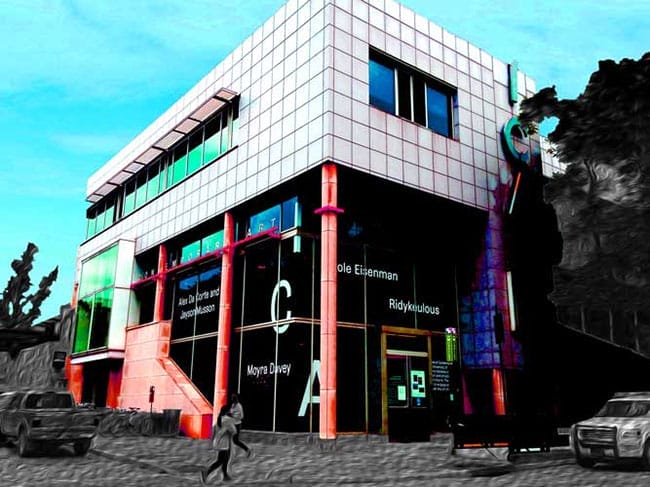Flexible. Intriguing. Creative. Challenging but manageable. Meaningful.
We wrote these words on the blackboard as our criteria for an ideal Management 100 client. Minutes later, despite the fact that we were entrepreneurs and scientists, not artists, we almost unanimously agreed on choosing the Institute of Contemporary Art (ICA), a renowned art museum located in the heart of Penn’s campus.
“We were looking for ambitious clients who shared our core values of exceptionalism, creativity and cohesion,” said my teammate Jack Cahn, who led our communication audit. “The ICA fit the bill perfectly.”
Management 100 is a Wharton freshman course described as upside-down, backwards and high-touch. Students take the test first, then study from it. In the first week of the class, about eight potential clients, usually nonprofit businesses varying in size and scope, come to Wharton to pitch their consulting projects to Management 100 students during class lecture. Student teams, each consisting of eight to 10 individuals, rank the clients according to their own preferences and thus have the opportunity to choose their own project.
The museum had just conducted a large-scale rebranding campaign for its 50th anniversary and wanted to know how well this campaign worked. That’s where we came in. We were enlisted to administer exit surveys as part of an analysis of visitor experience and conduct a communication audit. We were provided with social media analytics, advertising budgets, website survey results and a report from a similar consulting project conducted over the summer.
Through a month-long process that ultimately involved three separate surveys, more than 500 responses and over 5,000 data points, we found that the 50th anniversary campaign had worked. Social media, website and in-person traffic had increased over the past year. Moreover, the ICA boasts a 92 percent visitor satisfaction rate; if the ICA can get people through the door, visitors enjoy their experience.
“The greatest value [we provided] is the time that we put in to actually survey the people and contract the data,” said team member Ying Cong Seah, who worked on data analysis.

The ICA MGMT 100 team: Top row (left to right): Garrett Cayton, Hewan Tihuan, YC Seah, Jack Cahn. Bottom row (left to right): Sam Shea, Chen-hui Bergl, Elaine Chao, Margaret Schroeder.
In analyzing our survey data, we looked for growth opportunities for the Institute of Contemporary Art. We found that the 18- to 24-year-old demographic was underrepresented given the museum’s proximity to a college campus. In a survey administered to 150 Penn students, we learned that only 63 percent of respondents had heard of the ICA, even though they pass by the museum on a daily basis.
We recommended that the ICA “mobilize millennials” through targeted publicity campaigns on Penn’s campus, and we detailed specific outdoor, digital and print media buys that our research indicated would be most effective for the ICA.
In a 100-page final report, we detailed our observations, data, conclusions and recommendations. For example, we recommended increasing image-based social media content, purchasing more on-campus advertisements and forming relationships with student organizations. Second, as part of our communication audit, we included detailed analysis of the ICA’s social media engagement and current advertising allocations.
“All in all, our recommendations in the final report are small things [the ICA] can tweak that can actually have an impact in the long run,” said Elaine Chao, our team’s client contact.
By the time we finished surveying, we had become attached to the ICA and decided to begin implementing some of our recommendations. Team members Sam Shea and Hewan Tihuan spearheaded a community outreach initiative, during which we contacted over 100 schools in the Philadelphia area and made an effort to bring them to the ICA.
Meanwhile, the team’s number crunchers created a cross-tabulation of ZIP code data to indicate where the ICA was deriving most of its visitors. Others built partnerships with Penn Admissions and Residential Services and created a wiki page to drive post-visit engagement with the museum.
Splitting up into specialized groups allowed us to capitalize on our individual strengths and passions. We also put a lot of time into forming strong personal relationships with each other out of the classroom, which really improved the team dynamic.
In many ways, however, we owe our success to the ICA staff.
“[Our clients] Jill and Becky are two of the most flexible people I’ve ever met. I don’t remember them ever saying ‘no’ to us, and that was a boon,” said Seah. (Jill Katz and Rebecca Huff-Hunter are the ICA’s director of marketing and communications and communications associate, respectively).
“I think we lucked out with having really amazing clients who had a really quick turnaround. We’ve been able to get ideas past them and fix something quickly if there was a problem,” said Tihuan.
Now that the project is over, many team members have a newfound appreciation for art and plan to return to check out the next set of exhibits: Barbara Kasten’s Stages, Basel Abbas and Ruanne Rahme’s The Incidental Insurgents, and Traces in the Dark.
“I like seeing art that pushes people’s boundaries,” said Chen-hui Bergl, who led our surveying effort.
“[Contemporary art] gives you a different dimension to what you think art is,” added Chao. “I think it’s really soothing sitting [in the ICA]. … It slows down your tempo. Sometimes you are so busy focused on work, work, work, that you don’t appreciate the pretty things around you, like art.”
We hope that in the future more Penn students take advantage of the world-class contemporary art museum located in their backyard.
Editor’s note: Jack Cahn contributed to the writing of this blog.
























